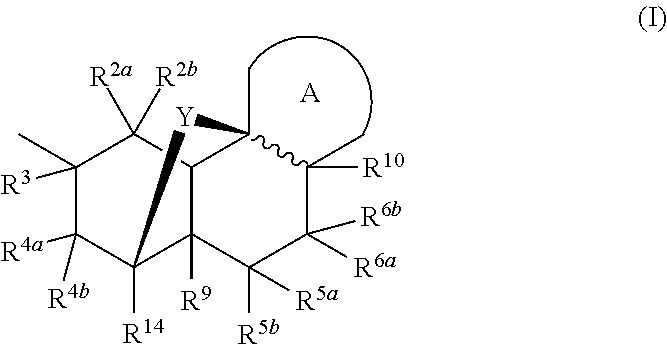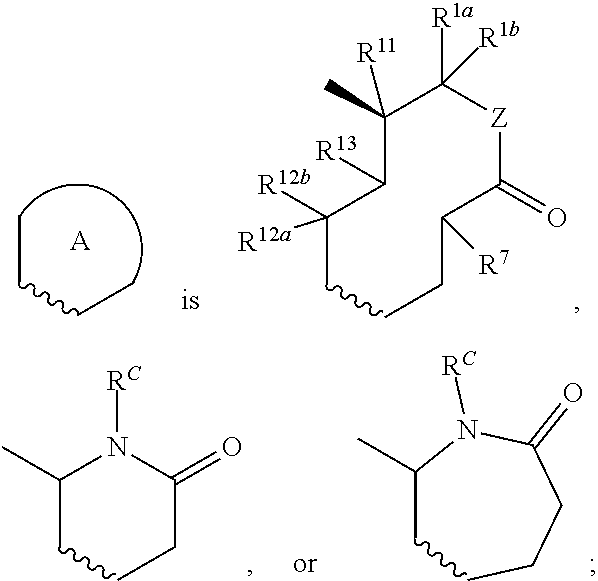Nargenicin compounds and uses thereof as antibacterial agents
a technology of nargenicin and compounds, which is applied in the field of nargenicin compounds, can solve the problems of poor prognosis of infected aids patients
- Summary
- Abstract
- Description
- Claims
- Application Information
AI Technical Summary
Benefits of technology
Problems solved by technology
Method used
Image
Examples
example 1
[0245]
(3R,4S,7S,8aS,10aR,11R,12R,13R,14R,14aS,14bS,E)-7-methoxy-1,3,13-trimethyl-6-oxo-14-4(2,2,2-trichloroacetyl)carbamoyl)oxy)-4-((R)-1-(((2,2,2-trichloroacetyl)carbamoyl)oxy)ethyl)-3,4,6,7,8,8a,10a,11,12,13,14,14 a-dodecahydro-11,14b-epoxynaphtho[2,1-e]oxecin-12-yl 1H-pyrrole-2-carboxylate.
[0246]Trichloroacetyl isocyanate (0.6 μl, 4.85 μmol) was added to a stirred solution of Nargenicin (2.5 mg, 4.85 μmol) in 1,2-dichloroethane (0.25 ml). The reaction mixture was a colorless solution that was stirred at room temperature. After 1 hour, the reaction mixture was evaporated under reduced pressure. The resulting residue was purified on a Waters Sunfire C18, 30×150 mm column, eluting with Acetonitrile / Water +0.1% TFA at 20 ml / min using a 12 minute 20-100% Acetonitrile / Water gradient followed by a 6 minute Acetonitrile flush. The product fractions were combined, evaporated under reduced pressure, and lyophilized from benzene to give the title compound as a white solid. LC-MS: calculated...
example 2
[0247]
(3R,4S,7S,8aS,10aR,11R,12R,13R,14R,14aS,14bS,E)-14-hydroxy-7-methoxy-1,3,13-trimethyl-6-oxo-4-((R)-1-((propylcarbamoyl)oxy)ethyl)-3 ,4,6,7,8,8a,10a,11,12,13,14,14a-dodecahydro-11,14b-epoxynaphtho[2,1-e]oxecin-12-yl 1H-pyrrole-2-carboxylate
[0248]N,N′-Carbonyldiimidazole (1.3 mg, 8.02 μmol) was added to a stirred solution of Nargenicin (4.0 mg, 7.76 μmol) in 1,2-dichloroethane (0.25 ml). The reaction mixture was a colorless solution that was stirred at room temperature. After 5.5 hours, N-propylamine (3 μl, 0.037 mmol) was added to the reaction mixture. After an additional 16 hours, the reaction mixture was evaporated and the resulting residue was placed under high vacuum. The residue was purified on a Waters Sunfire C18, 30×150 mm column, eluting with Acetonitrile / Water +0.1% TFA at 20 ml / min using a 17 minute 20-100% Acetonitrile / Water gradient followed by a 2 minute Acetonitrile flush. The product fractions were combined, evaporated under reduced pressure, and lyophilized fro...
examples 3-25
[0249]Examples 3-25 were generally prepared according to the methods in Example 2.
ExamplesStructure[M + H]+3686.374602.245630.306599.287[M + Na] 581.228663.339601.3010649.3411650.3112[M + Na] 639.52t-butyl ester was deblocked to the acid in 1:1dichloromethane / trifluoroacetic acid13[M + Na] 702.225 equivalents of triethylamine were used in this reaction.14671.3215603.2216[M + Na] 638.185 equivalents of triethylamine were used in this reaction.The reaction mixture was evaporated and methanol wasused as the solvent for the amine displacement of theimidazole ester.17681.195 equivalents of triethylamine were used in this reaction.The reaction mixture was evaporated and methanol wasused as the solvent for the amine displacement of theimidazole ester.18574.1819614.2520629.2821647.31The reaction mixture was evaporated and ethanol wasused as the solvent for the amine displacement of theimidazole ester.22663.29The reaction mixture was evaporated and isopropanol wasused as the solvent for the ...
PUM
| Property | Measurement | Unit |
|---|---|---|
| Force | aaaaa | aaaaa |
| Force | aaaaa | aaaaa |
| Force | aaaaa | aaaaa |
Abstract
Description
Claims
Application Information
 Login to View More
Login to View More - R&D
- Intellectual Property
- Life Sciences
- Materials
- Tech Scout
- Unparalleled Data Quality
- Higher Quality Content
- 60% Fewer Hallucinations
Browse by: Latest US Patents, China's latest patents, Technical Efficacy Thesaurus, Application Domain, Technology Topic, Popular Technical Reports.
© 2025 PatSnap. All rights reserved.Legal|Privacy policy|Modern Slavery Act Transparency Statement|Sitemap|About US| Contact US: help@patsnap.com



